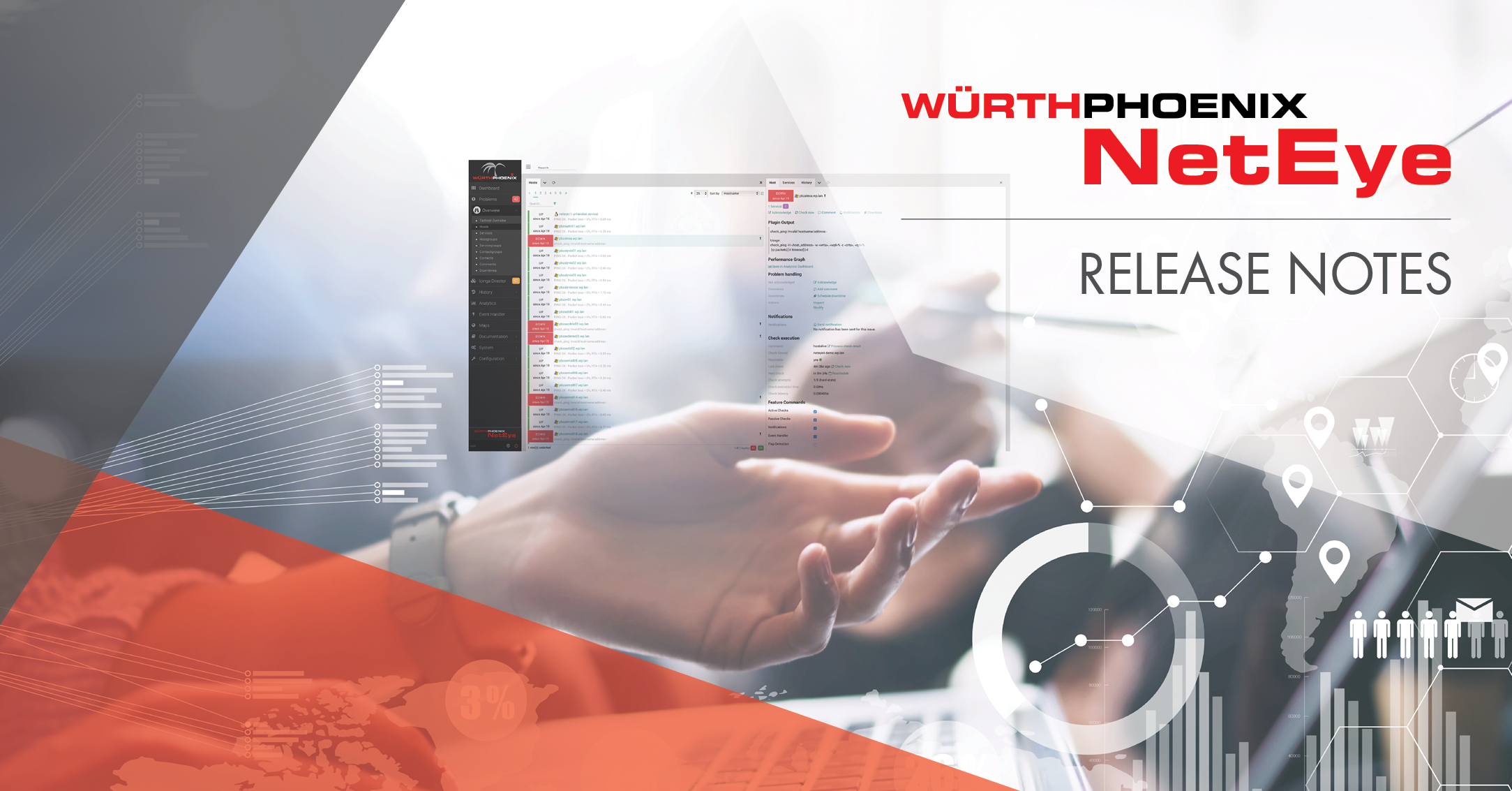NetEye 3.14 and NetEye 4.2 Release Notes
NetEye 3.14 Release Notes
Welcome to the latest version of our NetEye Unified Monitoring Solution that introduces an updated version of Grafana, customizable asset management import into monitoring, new profiles for Windows software in Monarch, and updated SMS gateway hardware. It also contains upgraded infrastructure for NetEye ITOA subscribers.
Product: NetEye
Release Number: 3.14
Release Date: July 31, 2018
Release Type: Minor
Previous Release: 3.13
System Requirements: NetEye 3.13
These release notes for NetEye 3.14 describe new features and improvements to version 3.13, and provide information on how to upgrade. The complete change log, which includes all fixed issues, is available in the “What’s New” section of the updated NetEye documentation (see the section “How to Upgrade” below).
New Features
Analytics Dashboard: Upgrade to Grafana Version 5
We have upgraded Grafana from version 4.6.3 to 5, allowing you to take advantage of the latest improvements from the Grafana dashboarding environment. These include a new dashboard layout engine, GUI improvements, dashboard folders, permissions for groups of users, and provisioning for datasources and dashboards. We have also completed the integration of Grafana’s user management (permissions and profiles) module into NetEye. While user authentication integration was introduced in NetEye 3.11, you can now grant permissions by assigning an authorization role for an organization in Grafana from within NetEye User Account Management.
Improvements
Filterable Imports from Asset Management into Monitoring
We have improved Monarch’s ability to import hosts from asset management. Now you can configure filters to limit the range of suggested hosts for import into monitoring, and customize attributes of an asset, such as “status”, “manufacturer”, “model” or any other attribute. We have included an example configuration file that illustrates how to implement these customizations.
New Windows Profiles for Monarch
To help speed up the setup of monitoring configurations and to better keep track of key performance indicators in more recent software such as Exchange 2016, we updated the configurations for monitoring profiles of some Windows services such as Exchange 2016. The checks themselves are carried out via PowerShell script, which is provided within the agent section of the NetEye File-Share.
SMS gateway support for a new GSM/UMTS device
Support for configuration of notifications and device-level drivers for the new Sierra FX30s modem via serial port has been added to the SMS Gateway. It has been validated for both voice calls and SMS/text.
Availability export feature: combined Warning and Okay status
This update creates an additional computed availability field that treats the Warning state as an Okay state. Thus you can use this field within queries in analysis dashboards without having to put the computation into the query itself.
New NetEye API v2
With this release, there is a new major version (v2) of the NetEye API. There are minor but breaking changes to version v1 on your NetEye installation, which you can read about by following the links Documentation > NetEye’s Perl API > Version v1. We still support the old v1 version of the API. If you encounter any problems or incompatibilities in your custom scripts, it is likely you will need to continue to use the v1 API. For instructions on maintaining backwards compatibility, please follow Documentation > NetEye’s Perl API > Backward Compatibility to find out more.
Technical Preview
Microsoft VMware Guest Performance Measurement with Upgraded NATS
High performance monitoring such as NetEye ITOA requires a higher frequency of data collection than Nagios typically provides. The ITOA architecture thus relies on technologies like NATS and Telegraf. With NetEye 3.14, monitoring data can now include VM counters obtained from a Windows guest OS via a Telegraf plugin. These counters can be especially helpful when troubleshooting, allowing you to remotely identify bottlenecks and resource contention on VMs. This preview updates NATS from version 0.4 to 0.9.2, and is intended for NetEye ITOA subscribers.
How to Upgrade
Upgrading from NetEye 3.13 to NetEye 3.14 can be performed locally by following the documentation already provided in NetEye 3.13. This upgrade procedure will still be possible for all future NetEye 3 minor releases. The base requirement is a NetEye 3.13 installation based on CentOS 6.
Step 1:
Update the NetEye 3.13 documentation package with the following command:
yum –enablerepo=neteye update neteye-documentation
Step 2:
Execute the upgrade procedure as described in the just updated documentation section “What’s New in NetEye?” at the link under “NetEye Upgraded Documentation”.
NetEye 4.2 Release Notes
Welcome to the latest version of our NetEye 4 Unified Monitoring Solution. Following version 4.1, this new version brings entirely new modules such as the Log Manager and the Lampo system-wide dynamic search, cluster capability out of the box, a new major version of Grafana, and backup and restore capability for Elasticsearch.
Product: NetEye
Release Number: 4.2
Release Date: July 31, 2018
Release Type: Minor
Previous Release: 4.1
System Requirements: NetEye 4.1
These release notes for NetEye 4.2 describe new features and improvements compared to version 4.1, and provide information on how to upgrade. The complete change log, which includes all fixed issues, is available in the “What’s New” section of the updated NetEye documentation (see the section “How to Upgrade” below).
New Features
Log Manager
We have integrated a large part of NetEye’s 3 Log Manager into NetEye 4, especially with the central monitoring configuration framework “Director”, allowing you to configure all hosts for Log Management and Monitoring in one place. The features ported include centralized Safed configuration, Log templates for fast configuration deployment to monitored host, and log checks. As part of this module, the features for log correlation are based on the Elastic 6 stack, consisting of Kibana, Logstash and Elasticsearch.
Cluster-Ready Architecture
NetEye 4.2 is deployed with a High Availability (HA) cluster architecture that has been designed for NetEye. It is built on RedHat 7’s cluster resource manager “Pacemaker”, and provides data replication for all failover services (databases, logs, configurations). In this way critical services, such as a monitoring master service or the database layer, can act within a high availability scenario, while additional services can be configured in a load-balancing mode without being limited to having one node completely idle (active-passive). This architecture supports monitoring check executions (Icinga2 satellite service) and log management data services.
Analytics Dashboard: Upgrade to Grafana Version 5
We have upgraded Grafana from version 4.6.3 to 5, allowing you to take advantage of the latest improvements from the Grafana team. These include a new dashboard layout engine, GUI improvements, dashboard folders, permissions for groups of users, and provisioning for datasources and dashboards.
Improvements
SMS gateway support for a new GSM/UMTS device
Support for configuration of notifications and device-level drivers for the new Sierra FX30s modem via serial port has been added to the SMS Gateway. It has been validated for both voice calls and SMS/text.
Elasticsearch backup and restore capability
This feature provides the ability to take and restore both full and incremental snapshots of Elasticsearch logs using the built-in Snapshot API. The backups can contain either individual indices or an entire cluster, and can even be stored remotely such as on a shared file system.
Technical Preview
Lampo System-Wide Search Feature
We have implemented a new, easier way to search and navigate across all of NetEye from a single interface, at any time. Called Lampo (Italian for “Lightning”), it can take just a few of your keystrokes and immediately return a list of relevant results. Clicking on one takes you straight to what you were searching for, whether it’s a monitored host, service, map, dashboard or module section. It uses fuzzy string search to find what you’re looking for, even when your spelling is a bit off.
Note: Lampo does not replace the original NetEye global search, but adds functionality. In fact, NetEye global search is still the main reference point for searching inside the documentation as Lampo does not yet search through the documentation.
Microsoft VMware Guest Performance Measurement with Upgraded NATS
High performance monitoring such as NetEye ITOA requires a higher frequency of data collection than Nagios typically provides. The ITOA architecture thus relies on technologies like NATS and Telegraf. With NetEye 4, monitoring data can now include VM counters obtained from a Windows guest OS via a Telegraf plugin. These counters can be especially helpful when troubleshooting, allowing you to remotely identify bottlenecks and resource contention on VMs. This preview updates NATS from version 0.4 to 0.9.2, and is intended for NetEye ITOA subscribers.
Check_Interface_Table
Check_interface_table is now NetEye 4 compliant. Of all the available monitoring checks, the check_interface_table check for network device interfaces is one of the most widely used.
How to Upgrade
Upgrading from NetEye 4.1 to NetEye 4.2 can be performed locally by following the documentation already provided in NetEye 4.1. This upgrade procedure will still be possible for all future NetEye 4 minor releases. The base requirement is a NetEye 4.1 installation based on CentOS 7.
Step 1:
Update the NetEye 4.1 documentation package with the following command:
yum –enablerepo=neteye update icingaweb2
Step 2:
Execute the upgrade procedure as described in the just updated documentation section “How to Upgrade” at the link under User Guide > Upgrading.
Contact
If you have any questions about this minor release, you are more than welcome to get in touch with us by sending email to neteye@wuerth-phoenix.com.








